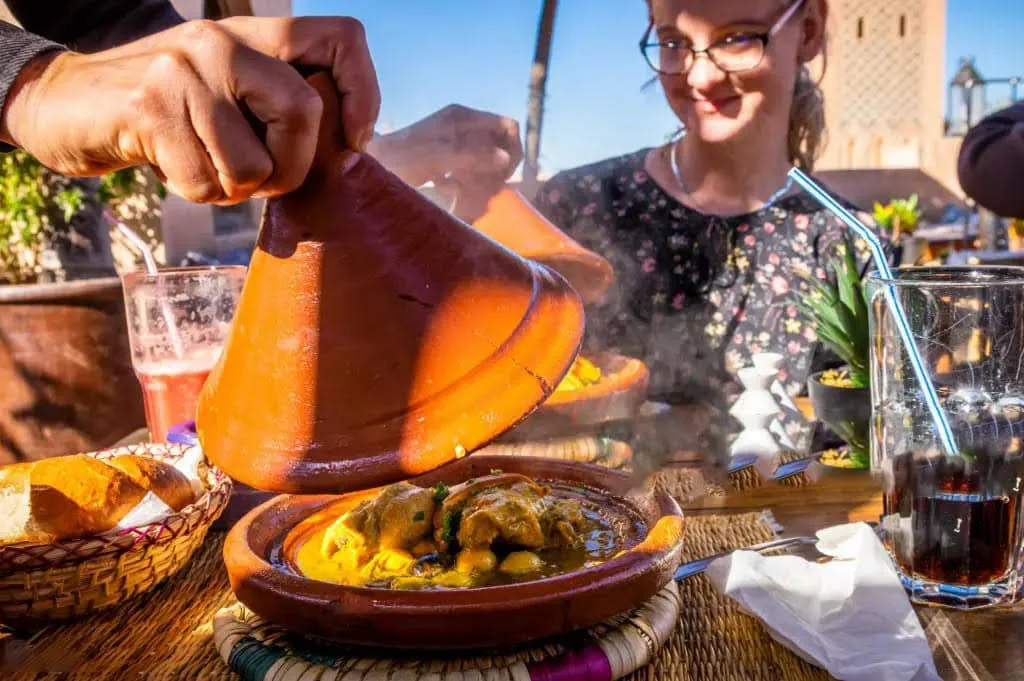
If you’re planning a culinary adventure in Morocco, one of the first questions many travelers ask is, “Is Moroccan food spicy?” The short answer is: not in the way you might expect. Moroccan cuisine is rich, aromatic, and layered with a variety of spices, but it’s not overwhelmingly hot like some other global cuisines. From flavorful tagines to freshly baked bread, Morocco offers a balanced and delightful array of tastes for every palate.
When people wonder “is Moroccan food spicy hot?”, it usually comes from seeing the variety of spices used in traditional dishes. Moroccan cooking relies on warm spices such as cumin, coriander, cinnamon, paprika, and saffron. These spices give dishes their signature flavors, warmth, and depth rather than pure heat.
For those sensitive to chili peppers, it’s important to note that most Moroccan dishes are not very hot. However, harissa, a traditional chili paste, is commonly used to add heat if desired. Many restaurants serve it on the side, allowing diners to adjust the spice level to their taste.
Morocco boasts an incredibly diverse culinary scene. When exploring Moroccan cuisine, you’ll encounter common Moroccan foods that are both flavorful and approachable:
Tagine: Slow-cooked stews named after the earthenware pot in which they’re prepared. Tagines often combine meat, vegetables, dried fruits, and a variety of spices for a rich, aromatic flavor.
Couscous: A staple dish of steamed semolina grains often served with vegetables, meat, or fish. Couscous is a traditional food Morocco loves for family meals and festive occasions.
Harira: A comforting soup made from tomatoes, lentils, chickpeas, and herbs. It’s often enjoyed during Ramadan but is delicious year-round.
Bastilla (Pastilla): A savory pie combining flaky pastry with spiced meat (often pigeon or chicken), almonds, and powdered sugar—a sweet-savory delight.
These dishes illustrate that Moroccan cuisine is all about aromatic, flavorful meals, rather than fiery heat.
Exploring typical Moroccan food reveals a rich palette of tastes and textures. Staples include:
Olive oil: Used generously for cooking and dressing salads.
Preserved lemons: Add bright, tangy notes to meats and vegetables.
Dried fruits and nuts: Apricots, raisins, and almonds balance savory dishes.
Spices: Cumin, paprika, cinnamon, turmeric, and saffron create signature Moroccan flavors.
Even dishes that include chili, like Harira or Harissa, allow diners to control the level of heat, so visitors don’t need to worry about overly spicy meals.
For those curious about traditional food Morocco, here are a few highlights:
Mechoui: Slow-roasted lamb seasoned with a mix of spices, often enjoyed during special occasions.
Rfissa: A comforting dish of chicken, lentils, and thin crepe-like bread with a fragrant spice blend.
Mint Tea: Sweet green tea with fresh mint, a national staple served in virtually every home and café.
These dishes emphasize the aromatic, savory, and sometimes sweet flavors that define Moroccan cuisine, not excessive spiciness.
Many travelers ask about the famous food of Morocco because the country’s cuisine is recognized worldwide for its intricate flavor profiles. Moroccan dishes are celebrated for:
Complex layering of spices that build flavor without overwhelming heat.
Balance of sweet and savory, often combining meats with fruits like apricots, dates, or prunes.
Fresh, local ingredients such as vegetables, olives, and herbs, ensuring every meal is full of natural taste.
Whether sampling street food in Marrakech or dining in a traditional riad, you’ll notice that Moroccan cuisine is more about fragrant, flavorful dishes than intense spice levels.
Ask About Spice Levels: If you’re sensitive to heat, let your server know. Harissa is usually optional.
Try Local Staples: Don’t miss couscous, tagine, and pastilla—they are core elements of Moroccan culinary culture.
Sample Sweets: Moroccan desserts like almond pastries, chebakia, and halwa add a sweet complement to savory meals.
Drink Mint Tea: It’s the perfect accompaniment to meals and an essential part of the Moroccan dining experience.
By exploring these dishes, you’ll understand that Moroccan food is flavorful, aromatic, and approachable for all tastes.
So, is Moroccan food spicy? The answer is yes, but in a nuanced way. Moroccan cuisine uses spices to enhance flavor, aroma, and depth rather than to overwhelm with heat. If you’re wondering “is Moroccan food spicy hot?”, most dishes are mild, with optional chili-based condiments like harissa for those who enjoy a kick.
From common Moroccan foods to typical Moroccan food and traditional food Morocco favorites, the country’s cuisine is a delightful journey for your taste buds. By sampling the famous food of Morocco, you’ll experience the balance, creativity, and richness that makes Moroccan cuisine so unique.
If you’re planning a Morocco Vacation, make sure to immerse yourself in the culinary culture—your senses will thank you!






Morocco Tours Planet – All Morocco, One Place
Follow Us
Payment channels
